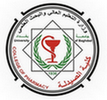The College of Pharmacy discussed the MSc thesis entitled “Design, Synthesis, Characterization, and Preliminary Anti-Microbial Evaluation of New Flurbiprofen Hydrazide Derivatives” by the student Hawraa Yusur Jasim and the supervisor, Assistant Professor Dr. Mohamad Kamil Hadi, at the Pharmaceutical Chemistry Department. The study aimed to synthesize compounds with expected antimicrobial properties since multidrug-resistant microorganisms are a contributing factor to mortality and morbidity. The study included conversion of 2-(2-fluoro-[1,1′-biphenyl]-4-yl)propanoic acid into a new class of compounds by reacting flurbiprofen ethyl ester with hydrazine hydrate to produce flurbiprofen hydrazide, which subsequently interacted with: 1) several aromatic aldehydes in absolute ethanol in the presence of a small amount of glacial acetic acid to yield Schiff base derivatives (IVa-e). 2) Three different sulfonyl chloride compounds (benzenesulfonyl chloride, 4-toleunesulfonyl chloride, and 4-chlorobenzenesulfonyl chloride) in the presence of triethylamine to yield the sulfonamide derivatives (Va-c). 3) Carbon disulfide was reacted to yield oxadiazole 2-thion, which was subsequently reacted with 4-chlorophenacyl bromide and 4-bromophenacyl bromide to yield the 1,3,4 oxadiazole derivatives (VIIa & VIIb). The results showed that compound Vc was more potent on G(+)ve and G(-)ve bacteria and fungus compared to other synthesized final compounds. Compounds Vc and IVe exhibited a greater inhibition zone on G(-)ve bacteria and G(+)ve bacteria, respectively. Compared to other final compounds, compounds IVa and IVd exhibited a higher zone of inhibition on C. albicans. The study recommended the synthesis of more Schiff bases, sulfonamides, and oxadiazole derivatives and evaluating their antimicrobial and anti-inflammatory activities as final compounds.




